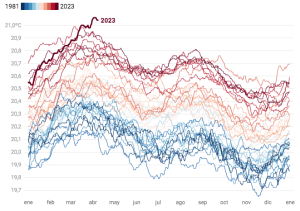
©NOAA
La medición de la temperatura del agua del mar de este mes de abril es la más alta de los últimos 45 años. Esto es debido al final del fenómeno llamado La Niña.
Tanto los fenómenos de El Niño y La Niña son ejemplos claros de los cambios climáticos globales, siento parte fundamental de un sistema de fluctuaciones climáticas. El Niño es conocido como el período cálido y La Niña como el período frío, caracterizada por tener temperaturas frías si se le compara con El Niño, que presenta temperaturas oceánicas inusualmente calientes en la zona ecuatorial.
Atendiendo a estos fenómenos, las temperaturas subsuperficiales se vuelven cada vez más cálidas de normal en los sectores occidental y central de la zona ecuatorial del océano Pacífico, creándose condiciones favorables para una transición a un episodio de El Niño. Los factores críticos que determinan la transición son los vientos del Este de nivel bajo.
Según el meteorólogo J.J González Alemán, los océanos entran en territorio desconocido, refiriéndose a récord de temperatura del agua del mar medido por los satélites el 8 de abril de este mismo año. La media oceánica llegó hasta los 21º C, superando el récord de 2016.
Mientras la costra gaseosa creada al lanzar CO2 crecía y atrapaba el calor, La Niña refrescaba la superficie del Pacífico que, además, ha sido inusualmente prolongada. La Oficina Nacional de Administración Oceánica y Atmosférica (NOAA) ha considerado que La Niña había llegado a su fin a comienzos de marzo.
Así, una vez finalizado, la Tierra se encuentra en fase de transición hacia la situación inversa, que recalentará el agua. Sin embargo, en este mes de abril o ha existido compensación y los efectos del cambio climático se hacen más evidente con este fenómeno.
En España, el mar Mediterráneo en verano encadenó ollas de calor marino, llegando a los 30º C en el mar Balear. Como consecuencia, todas las regiones del Mediterráneo Occidental sufrieron eventos extremos. Pero al llegar el otoño e invierno, esta situación no cambió, existiendo olas de calor en pleno enero.
__
“LA NIÑA” PHENOMENON
This April’s sea water temperature measurement is the highest in the last 45 years. This is due to the end of the La Niña phenomenon.
Both El Niño and La Niña phenomena are clear examples of global climate changes, I feel a fundamental part of a system of climate fluctuations. El Niño is known as the warm period and La Niña as the cold period, characterized by cold temperatures compared to El Niño, which presents unusually warm ocean temperatures in the equatorial zone.
In response to these phenomena, subsurface temperatures become increasingly warmer than normal in the western and central sectors of the equatorial zone of the Pacific Ocean, creating favorable conditions for a transition to an El Niño episode. The critical factors determining the transition are low-level easterly winds.
According to meteorologist J.J. González Alemán, the oceans are entering uncharted territory, referring to the record seawater temperature measured by satellites on April 8 of this year. The ocean average reached up to 21º C, surpassing the 2016 record.
While the gaseous crust created by spewing CO2 grew and trapped heat, La Niña cooled the Pacific surface, which has also been unusually prolonged. The National Oceanic and Atmospheric Administration (NOAA) considered that La Niña had come to an end at the beginning of March.
Thus, once it ended, the Earth is in transition to the reverse situation, which will reheat the water. However, in this month of April there has been no compensation and the effects of climate change are more evident with this phenomenon.
In Spain, the Mediterranean Sea in summer chained pots of marine heat, reaching 30º C in the Balearic Sea. As a consequence, all regions of the Western Mediterranean suffered extreme events. But when autumn and winter arrived, this situation did not change, with heat waves in the middle of January.
__

